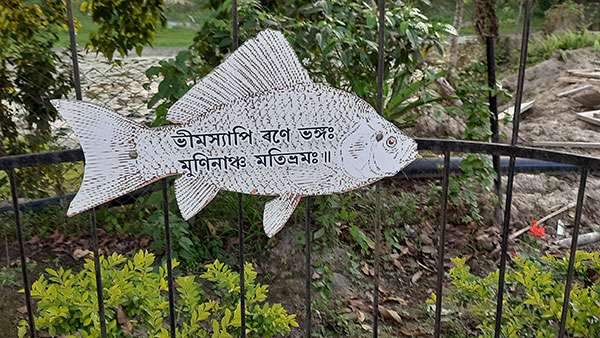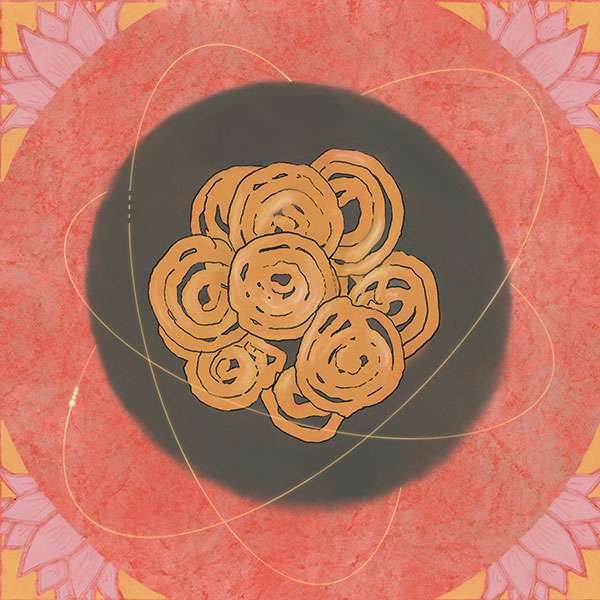MEDIA
Ancient Manuscripts and Assault Rifles: On the Trail of Rohu and Jalebi
www.oneating.in | September 9, 2021
One
In an essay on Hindu food practices, A K Ramanujan narrates a tale about a student in a gurukul whose master instructs his wife to serve the young boy only rice with castor oil. The student eats it dutifully without complaining about, or even noticing, the bitter taste. Many years later he expresses his displeasure with the food only to be told by the master that his education is over, and he can step out into the world.
The anecdote, which seems to be an integral part of Hindu belief system, emphasises that subduing one’s taste buds is necessary during brahmacharya or the stage of learning and meditation. Any epicurean indulgence can stir up desires, and hence is a deviation from the pursuit of wisdom. It also suggests that after one’s education is over, one is ready to reject bland food and enjoy the pleasure of, and desire for, delicacies.
The proposition that simple food enables one’s journey to a higher existential plane is among the myths many Indians hold dearly about their civilisation; myths that may reveal a different reality upon scrutiny. Edibles prohibited in one part of the country are relished in the other, and there are monasteries whose monks revel in delicacies.
Once, I was travelling in Assam for reporting on the state assembly elections and, taking several detours, found myself crossing the Brahmaputra to reach Majuli, the great riverine island that houses Vaishnavite monasteries. The monks studied and worked on old texts and manuscripts. They also loved their fish, strictly prohibited for Vaishnavite devotees in some holy towns of north India like Mathura or Vrindavan. The fish was not limited to the dinner table in Majuli. It was the most conspicuous image in the monastery, from large sculptures to plaques carrying mantras. One such fish-shaped plaque at a monastery called Auniati Satra had a Sanskrit shloka inscribed in the Assamese language: “Whatever I write may be wrong because even Bhima was defeated in a battle.”

Photo Courtesy – Ashutosh Bhardwaj
Professor Dambarudhar Nath, who spent his childhood in one such monastery on the island, and was now the founder Vice-Chancellor of a university coming up along the banks of the Old Brahmaputra, told me that the shloka appears at the end of several Sanskrit texts as an apology by the anonymous manuscript-copier, a humble admission of his fallibility that he might have committed several mistakes in copying and thus deviated from the ‘original’ text. It explained why there was rarely a single version of several ancient and medieval manuscripts, which passed through one generation to the other through diligent copiers, and even the greatest copier couldn’t have easily offered a ‘true’ facsimile. When you copy any text verbatim, Jorge Luis Borges said in precise words, it becomes a new text. But the shloka could also be a narrative device to add a layer of ambiguity in the text and complicate its reading and receptions, and it could also reflect a desire of the anonymous copier to leave his fingerprints on the text.

Prof. Dambarudhar Nath
Photo Courtesy – Ashutosh Bhardwaj
I found it fascinating that the humble admission or a subtle authorial assertion, as it were, was inscribed on an image of rohu fish, the prime delicacy in that part of India. The monks chose to inscribe a shloka that underlines the multiplicity of a text on a fish, which itself is best relished with a variety of recipes, was perhaps indicative of the essential character of both the text as well as the food. There can be no single assertion about food; it is a celebration of various beliefs and recipes, their multiple sources and origin points.
Many centuries later, Umberto Eco’s narrator inserted a similar admission in the foreword of the manuscript that he had found and later copied. I also recall that the Christian monastery in The Name of The Rose has a vivid description of a pork recipe the monks savour. If stirred promptly, the blood of freshly slaughtered pigs won’t coagulate and could be used to prepare delicious blood puddings.
The proposition that epicurean joys ought to be surrendered for a meditative life is contested by texts as well as by actual practices. Sanskrit scriptures describe various delicacies and joys of a sumptuous meal. Even characters considered to be stoic have an ample palate. On their exile from Ayodhya, Rama, Sita and Laxmana cross the Ganga in a boat. As they reach the middle of the stream, Sita promises the Ganga that upon their safe return she will worship her with “thousand pots of spirituous liquor and jellied meat with cooked rice”. The image of Sita, that epitome of austerity, offering liquor and meat to the holy river in the Valmiki Ramayana, should not surprise us given the emphatic declaration in the Upanishads about food (anna) being brahman or the ultimate reality.
Having offered a counter to the belief contained in Ramanujan’s anecdote, we can now make two propositions. First, the preparation of a meal, with love, can be meditative. With various fumes wafting in the air and smells of spices converge with each other, the kitchen is transformed into a space where one’s anxieties and stress dissolve into the joy of a perfect recipe.
Second, a rewarding meal can also take one to bliss and, at times, the simplest meal can be orgasmic. For evidence we can again move to an Eastern text, the Japanese movie Tampopo, which is about the joys of an epicurean life. In an extraordinary sequence, a woman reaches the peak of her sexual tension and achieves an orgasm after a man feeds her the yolk of a soft-boiled egg. He neatly places it in her mouth through his mouth in a way that the yolk becomes a phallic symbol. She doesn’t swallow it completely, only swirls the yellow ring in her mouth and that’s sufficient to send her into a trance.
One can also note that among the sixty-four kinds of kala or arts mentioned in the Kamasutra is the art of cooking and preparing drinks.
Let us end this section with a movie that my French friend Judith Misrahi-Barak reminded me of recently, a film that is perhaps the greatest ever made on food, and one that also sums up my argument. Babette’s Feast is a story of two elderly pious women who belong to a Protestant community in 19th century Denmark. They live an austere life, eat bland food and consider any form of pleasure as sin against the divine order. For them abstinence is a penance for all the sins they have committed, sins that are never spelt out and hence seem imagined ones. In such a life arrives an outsider, Babette, seeking shelter. Having escaped the ongoing violence in Paris, she requests the sisters to give her asylum in lieu of which she would offer them her services for free. The elderly women reluctantly allow her initially, but Babette soon wins over their heart.
Many years later, she wins a lottery and can now go back to her home in Paris with this award money. Before her departure, however, she wants to thank the community in the only way she knows of — by preparing a grand feast. She spends all her money over the feast that the elderly women consider decadent for them. As they quietly break the bread, their skepticism gradually vanishes and they realise a joy they had never known. The feast assumes a spiritual connotation, it nourishes both the body and soul of the austere women, and the dinner table becomes a site of redemption.

Artwork Courtesy – Saronik Bosu
Two
If preparation and relishing of food can be meditative and blissful, alcohol enables absorbing conversations that lead to revelations and realisations. A good meal takes one to a meditative stage, alcohol takes the meditation forward, often prompting new discoveries about one’s self. A nice drink can act as a catalyst, a conspirator to a variety of conversations, both profound and playful.
Nirmal Verma once wrote about those long and lonely evenings he spent in bars of various European cities in the 1960s, the evenings that incubated his short stories. Down with alcohol, strangers would visit his table and reveal their lives to him. “You are a quiet Indian, aren’t you”” they asked him and plonked themselves on a nearby chair. “A part of what I am today is a contribution of those anonymous people,” Verma later wrote about the people who made him realise the “dark corners” of life he had “always concealed away”.
His short story Dedh Inch Upar (An Inch and a Half Above Ground, 1966) is a poignant monologue of a Jew who bares his soul to a stranger in a bar, the arrest and subsequent killing of his wife by the Gestapo several decades ago. He had no inkling during the seven years of their marriage about her being an anti-Nazi political activist. After her arrest, the Gestapo tortured him to extract more about her, but he knew nothing. Years later, the memories of those days tormented him. “Earlier, the realisation that she’d kept me in the dark had hurt. But later, in the midst of the torture, I was grateful she hadn’t told me anything.”
“Imagine my agony if the choice to confess had existed! One can bear suffering when there is no way out. But suppose you know you can put an end to your suffering by betraying your wife or your father or your brother or your lover…Did she keep me in the dark to spare me the agony of that choice?”
The man peels off several layers of his existence, his vulnerabilities and dilemmas over beer, as the short story becomes a remarkable document about Jewish life during the Nazi rule. To a reader far removed, both spatially and temporally, from mid-twentieth century Europe, this alcohol-induced monologue becomes a frame to examine a fundamental question about the multiplicity or the absence of choices, the torment associated with the former as opposed to the simplistic clarity when one takes a predetermined path.
My journalistic life often takes me to places where alcohol appears to be the only medium to strike a conversation with the most diffident people in the most difficult situations. However, at the end of the evening, our apprehensions are shed and a friendship begins. It is often considered to be an effective way to strike a conversation, but alcohol could also be a sacred potion that erases the boundaries of time and age.
Let me end with one of my most memorable feasts that, incidentally, came on a journalistic assignment. Now in its sixth decade, the Naxal insurgency is the longest running armed insurrection against the Indian state. In March 2014 I spent three weeks in the Naxal camps in Abujhmad forest of Bastar, the capital of the insurgency. The rebels make a provision for a mutton feast once a month for every squad; a separate fund is earmarked for the celebration. When the date of my departure arrived, the day of the feast was still far away. They wanted to treat me, but could not have withdrawn money from the fund in advance. The insurgents held a quick meeting and decided that they would talk to their bosses about it later, but they had to give a farewell to their guest. When they gleefully informed me about the feast, I disappointed them by telling them that I was vegetarian.
They didn’t believe it. How could anyone live without mutton? How do people live in the city? But the farewell had to be organized, so a cadre suggested jalebis for me. The market was several hours away, but a villager was asked to leave immediately on a bicycle. By the time the jalebis that were already several days old arrived, they had turned dry and yellow. We all sat on the ground, and, guarded by armed guerrilla fighters, savoured the sweet together. I had spent the previous three weeks with an impending fear of a police attack on the Naxal camp, and my resultant death by the bullets or a grenade. On the last day, all I needed were a few jalebis to reaffirm my faith in the cosmos.

Artwork Courtesy – Saronik Bosu
(Source: https://oneating.in/trail-of-rohu-and-jalebi/)
(The author, Ashutosh Bhardwaj is an alumnus of FLAME.)

